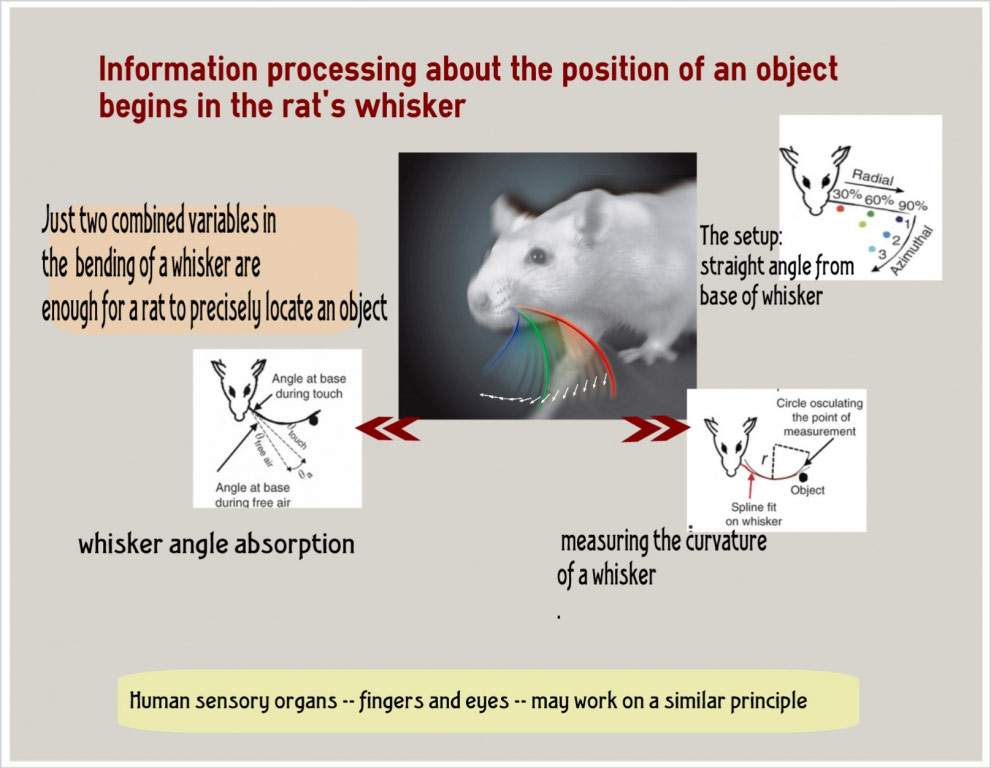In the experiments, objects were placed in various positions near the rats’ heads. In the first series of trials, the rats were anesthetized and their whisker hairs activated by the electrical stimulation of their motor nerves. This gave the researchers precise control over the whiskers’ movements. The entire experiment was filmed on a high-speed camera, which enabled the scientists to precisely measure the changes in a whisker hair as it came into contact with the object. They identified four variables: global bending over the entire hair, the amount of bending at the base, the angle of the hair in relation to the rat’s head and the extent of angular movement that is blocked by the contact (angle absorption).
The research team – which included Dr. Knarik Bagdasarian, then research students Drs. Marcin Szwed, Per Magne Knutsen, Maciej Pietr and Erez Simony, and research student David Deutsch – discovered that just knowing the figures for each pair of angular and bending variables was sufficient to pinpoint exactly where the object was in relation to the rat’s head. The closer it was to the head, the greater the bending at the base and angle absorption, and the smaller the global bending and angle protraction. The combinations of bending and angular variables also revealed the angle of the object in relation to the nose-tail axis of the rat’s head. These two pieces of information – distance and angle – identified the object’s precise location. The scientists then observed the process in alert rats that were allowed to move their whiskers naturally; they found that the same relationships held true.
These results, which were published in
Nature Neuroscience, imply that we may need to update the way we describe the process of perception. Today, we know that perception is both an active process and a cyclical one. For example, movement leads to interaction with an object (e.g., a finger alights on a tabletop), and receptors in the organ (finger) activate sensory nerves. These cells conduct information (finger is touching a surface) to the brain. Processing this information leads to the initiation of further movement (sliding the finger across the table’s surface to feel its texture). But, according to the present study, the morphology – physical form and structure – of the sensing organ are an integral part of the cycle, and they enter it at an early stage. In fact, morphological information – bending and angle in the case of the whiskers – appear to be processed mechanically in the follicle before being sent as electrical signals to nerve cells in the brain.
Although the experiment was conducted on rat whiskers, Ahissar believes that this absorption and processing of information arising from the physical properties of the organ may be relevant to other senses and other animals, including humans. Our sense of touch, for instance, is dependent on movement: how much pressure we exert, whether we move our fingers over an object quickly or slowly, and the morphology of our fingertips – all determine which receptors are activated and what signals will be sent to our brain. Even sight, which is still often misconstrued as a passive sense, depends on movement. When we look at faces, for instance, our focus jumps from feature to feature – eyes, nose, mouth – in a sort of visual “touching.” The properties of our eye movements, combined with the morphology of our eyeball, cornea, retina and other parts of the eye determine how accurately we perceive the world through our sense of sight. In other words, the divide between sensing and perception – the first thought to be a function of our external sensory organs, the second the result of processing the data from those sensory organs in the brain – may not be as clear cut as we thought.
Prof. Ehud Ahissar's research is supported by the Murray H. and Meyer Grodetsky Center for Research of Higher Brain Functions; the Jeanne and Joseph Nissim Foundation for Life Sciences Research' the Kahn Family Research Center for Systems Biology of the Human Cell; Lord David Alliance, CBE; the Berlin Family Foundation; Jack and Lenore Lowenthal, Brooklyn, NY; Research in Memory of Irving Bieber, M.D. and Toby Bieber, M.D.; the Harris Foundation for Brain Research; and the Joseph D. Shane Fund for Neurosciences. Prof. Ahissar is the incumbent of the Helen Diller Family Professorial Chair in Neurobiology.

